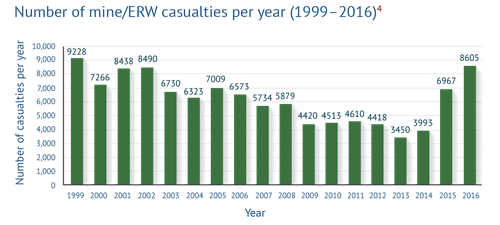Landmine Monitor 2017
Casualties
Overview
High numbers of casualties were recorded in 2016, with a total of at least 8,605 people killed or injured by landmines, including improvised landmines, as well as unexploded cluster submunitions,[1] and other explosive remnants of war (ERW)—henceforth mines/ERW.[2]
This was another increase in the number of recorded casualties, following the sharp rise in 2015 when there were 6,967 casualties.[3]
This continued increase in 2016 was largely a result of more mine/ERW casualties recorded in countries experiencing armed conflict. The casualty total in 2016 is the second highest of all years in Monitor data except for 1999—the first year of Monitor recording. It also marked the highest number of casualties caused by improvised mines on record for the Monitor.
Of the total of 8,605 mine/ERW casualties the Monitor recorded for 2016, at least 2,089 people were killed and another 6,491 people were injured; for 25 casualties, it was not known if the person survived or was killed.
Civilians represented the vast majority of casualties compared to military and security forces,[5] where the civilian status was known, continuing a clear trend of civilian harm over time: 78% of casualties were civilians in 2016, comparable to 79% in 2015.[6]
Declining casualty rates were recorded in Cambodia and Colombia in 2016, two States Parties that in the past were among those with the highest number of casualties. For the first time—since annual recording started for Cambodia in 1994 and since the year 2000 for Colombia—both recorded fewer than 100 casualties each.
Casualties were identified in a total of 56 states and other areas in 2016.[7]
Overall, in 2016 casualties decreased in 31 states and areas from 2015,[8] remained the same in another four[9] and increased in 30 states.[10] Of these, five countries (Afghanistan, Libya, Myanmar, Ukraine, and Yemen) accounted for 85% of the cumulative annual increase in recorded casualties from 2015.[11]
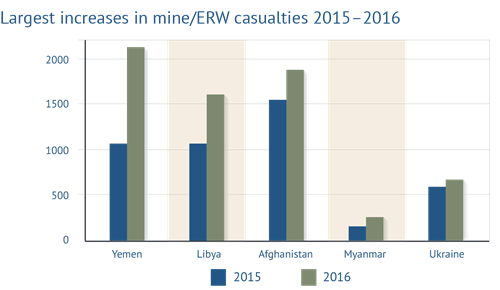
With continued increases in casualties each year since 2013, the total of 8,605 mine/ERW casualties recorded in 2016 mirrored the high casualty numbers documented in the early years of the Mine Ban Treaty. This is reflected in an average incidence rate of 23 mine/ERW casualties per day in 2016, compared to less than 10 casualties per day in 2013, the year for which the lowest number of annual casualties were recorded by the Monitor. In 1999, there was an average of 25 mine/ERW casualties per day. The similarity is also echoed in the many casualties not disaggregated by the mine or ERW device type.
In the first years of the Mine Ban Treaty, it was certain that many casualties went unrecorded. In 1999, the Monitor identified some 9,000 casualties, but estimates indicated that there were another 7,000–13,000 annual casualties that were not recorded in the available data. From 1999 through 2006 the estimated number of new mine casualties (recorded and estimated) each year was between 15,000 and 20,000. The Monitor estimated that there have been approximately 1,000 additional casualties (an additional 25–30% of the total) each year between 2009 and 2014 that are not captured in its global mine/ERW casualty statistics, with most occurring in severely affected countries and those experiencing conflict. However, with the highly irregular accessibility of data for countries experiencing conflict in 2015 and 2016, estimating the gaps has become less viable as has the ability to disaggregate casualties by device type.
The Monitor has recorded more than 110,000 mine/ERW casualties for the 17-year period since its global tracking began in 1999,[12] including at least 80,000 new survivors.[13] Mine/ERW incidents impact not only the direct casualties—the boys, girls, women, and men who were killed, as well as the survivors—but also members of their families struggling under new physical, psychological, and economic pressures. As in previous years, there was no substantial data available on the numbers of people indirectly impacted as a result of mine/ERW casualties.
Of the total casualties in 2016, 66% (5,715) occurred in 35 States Parties to the Mine Ban Treaty.[14]
Casualty Recording for 2016
As in previous years, the mine/ERW casualties identified in 2016 only include recorded casualties, not estimates. It is certain that there are additional casualties each year that are not captured in the Monitor’s global mine/ERW casualty statistics, with most occurring in severely affected countries and those experiencing conflict. In some states and areas, numerous casualties go unrecorded; therefore, the true casualty figure is likely significantly higher in those countries.
The data collected by the Monitor is the most comprehensive and widely-used annual, and global, dataset of casualties caused by mines/ERW. The casualty total for 2016 included datasets or reporting from the following types of sources: international organizations, UN and national mine action centers, other UN agencies, humanitarian mine action operators, ICBL members, and other NGOs, as well as media scanning.[15]
Mines, including improvised mines, and other ERW remain a menace to civilians, often including the most vulnerable and marginalized people in their countries and communities. Their fate typically does not always make it into headlines and newsfeeds. While the monitor draws on media scanning in several languages as well as other publicly available documentation, access to a broad variety of other sources is vital when compiling a global overview of the harm caused. This is why the Monitor relies on the many sources and data providers listed above.
In 2016, significant underreporting of casualties for Iraq continued to be apparent. This seems to be exacerbated by a severe deficiency in the recording of improvised mine casualties.[16]
A decrease in the annual total of casualties for Syria was strongly influenced by a lack of data on persons injured by mines/ERW (survivors). For 2016 and all years since 2012, except 2015, data available is primarily from fatality counts registered in conflict recording systems. However, in 2015, for Syria the availability of data from an extensive one-time multi-country survey project including Syrian refuges, by Handicap International (HI), marked the first time since the beginning of the conflict that a substantial dataset on persons in Syria injured by mines/ERW who survived was available.[17]
ICRC reporting had the largest number of casualties of any source for Yemen and Libya in 2016. These casualties are reported collectively as landmines and ERW casualties without the mine/ERW types differentiated.
In Yemen, 2,037 people injured by mines/ERW were admitted into 46 ICRC-supported hospitals, among an annual total of 33,230 weapon-wounded patients treated in 2016.[18] For 2015, the ICRC reported 812 persons injured by mines/ERW admitted to ICRC-supported healthcare facilities, among an annual total of 28,565 weapon-wounded patients treated.[19] The ICRC data was not disaggregated by age, gender, or device causing casualties; however, the ICRC has noted that the majority of casualties were male.[20] Some other datasets were not disaggregated by calendar year. During 2016 and through April 2017, the Yemen Mine Action Center’s (YEMAC) office in Sanaa registered 1,020 casualties, but was unable to provide details for these casualties.[21] The YEMAC office in Aden registered 566 casualties from March 2015 to March 2017.[22]
Of the 1,610 mine/ERW casualties recorded by the Monitor for Libya in 2016, a total of 1,465 were ICRC-reported injured mine/ERW casualties admitted to hospitals it supported across Libya,[23] among 6,772 weapon-wounded patients treated in 2016.[24] The vast majority of mine/ERW casualties for Libya in 2015 recorded in the Libyan Mine Action Center (LibMAC) database[25]—935 persons reported injured by ERW[26]—were recorded during HI surveys at two hospitals in Tripoli.[27]
Although ICRC data was not disaggregated by device type, available information from other reliable sources pointed to widespread landmine and improvised mine contamination as a threat in Libya in 2016. For example, it was reported that “ISIS [Islamic State] left behind a jungle of land mines,” in Sirt.[28] Two consecutive UN Secretary-Generals noted “the widespread contamination with explosive hazards, including improvised explosive devices, in the areas of Sirte and Benghazi, where the risk of injury and death to civilians and to humanitarian actors is high,”[29] and that it “continues to threaten civilians and humanitarian actors in areas such as Benghazi and Tripoli.”[30]
Casualty demographics[31]
There were at least 1,544 child casualties in 2016, the highest annual total since the Monitor began its recording in 1999. Child casualties in 2016 accounted for 42% of all civilian casualties for whom the age group was known (3,634).[32] This was the similar to the 40% recorded for 2015. Children were killed (498) or injured (1,046) by mines/ERW in 36 countries and other areas in 2016.[33]
As in previous years, in 2016 the vast majority of child casualties where the sex was known were boys (81%).[34]
ERW caused the most child casualties (669, or 43%), followed by improvised mines (437, or 28%). Unexploded cluster submunitions caused more child casualties (64) than antivehicle mines (61). (For more information on child casualties and assistance see the annual Monitor fact sheet on landmines/ERW and children.)
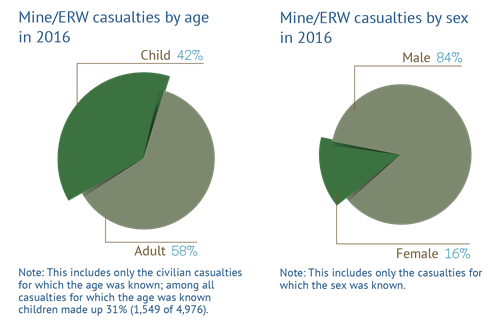
In 2016, men and boys made up the vast majority of all casualties, with 84% of all civilian casualties for which the sex was known (2,787 of 3,317). Women and girls made up 16% of all civilian casualties for which the sex was known (530).
In 2016, there were 102 casualties identified among deminers (25 deminers were killed and 77 injured) in 16 states and one area.[35] This represented an increase from 2015, when 42 deminer casualties were recorded in 10 states. It was however, similar to the average of 99 casualties among deminers per year recorded by the Monitor since 1999. Between 1999 and 2016, the Monitor identified more than 1,750 deminers who were killed or injured while undertaking clearance operations.[36]
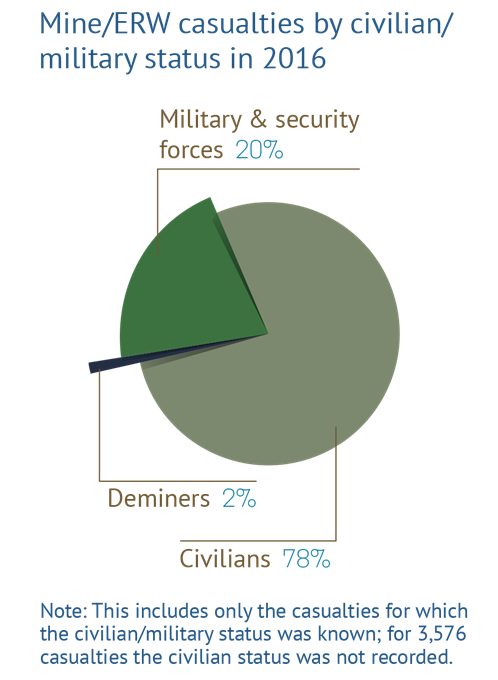
Civilian casualties represented 78% of casualties in 2016 where the civilian/military status was known (3,921 of 5,029).[37]
The country with the most recorded military casualties of mines/ERW in 2016 was Ukraine, with 435; followed by Mali, with 82 military casualties (including peacekeeping forces); and Pakistan with 81 military and combatant casualties recorded (including soldiers, militia, and militants).
Mine/ERW types resulting in casualties
In 2016, landmines caused at least 3,570 casualties—including factory-made antipersonnel mines (732), victim-activated improvised mines (1,805), antivehicle mines (495), and unspecified mine types (538).
Unexploded submunitions caused 114 casualties and other ERW 1,078 casualties. A total of 3,843 casualties were the result of mine/ERW items that were not disaggregated in data.

The 1,805 improvised mine casualties recorded for 2016 was the highest annual total of such casualties recorded since Monitor reporting began in 1999, the next highest number in Monitor data is 1,721 recorded for 2012. Casualties from improvised mines were identified in 17 states in 2016.[38] Most improvised mine casualties in 2016 occurred in Afghanistan (1,180).
Historically, the number of improvised mine casualties (also recorded as victim-activated IED casualties) was underreported due to their being recorded as other mine/ERW categories. Casualties in Colombia that were recorded as antipersonnel landmine casualties have been reclassified in Monitor data as improvised mine casualties. It was noted in 2017 that most such casualties in Colombia were caused by improvised antipersonnel mines and no factory-made antipersonnel mines casualties were known to have been recorded in the national casualty database. Among casualties recorded as caused by antipersonnel landmines in Myanmar, it is also extremely likely that there are casualties of improvised antipersonnel mines.
A difference in terminology between Cameroon and Nigeria was apparent, despite the same non-state armed group using improvised mines in both. Media reporting for Cameroon consistently used “mine,” while for Nigeria both “landmines” and “IEDs” were reported as causing casualties. In India, media reporting specified that improvised mines were activated by the presence of a person or vehicle, including pressure-plate activated devices, accounting for the significant increase in casualties from seven in 2015 to 79 in 2016.[39]
Casualties recorded as caused by antipersonnel mines increased from 602 in 2015 to 732 in 2016, with casualties recorded in 23 states and areas.[40]
In 2016, antivehicle mines caused at least 495 casualties in 19 states and other areas.[41] The states with the greatest numbers of casualties reported from antivehicle mines were Ukraine (127) and Yemen (103). In 2015, antivehicle mines caused 459 casualties.[42]
Casualties recorded as being due to unspecified mine types decreased to 538 in 2016 from 941 in 2015. This was mostly attributable to there being a far greater number of casualties recorded as caused by unknown mine/ERW items in 2016, which would encompass various mine types.[43]
In 2016, 1,078 casualties were caused by ERW in 39 states and areas,[44] with 1,932 ERW casualties recorded for 2015. Children (669) made up 66% of civilian ERW casualties in 2016, when the age group was recorded.[45]
In 2016, the number of casualties of unknown mine/ERW items in the Monitor global total jumped to 3,843, compared to 1,410 in 2015 and just 279 in 2014. For 2016, about half (1,943, or 51%) of all casualties of unknown mine/ERW items were recorded in Yemen, and another 39% were recorded in Libya (1,493). The overwhelming majority of casualties of such unknown items were injured persons (3,648), with most documented and reported in health facility records under a general default category of landmines and ERW.[46] The remaining 407 casualties of unknown mine/ERW items occurred in 15 countries in 2016.[47]
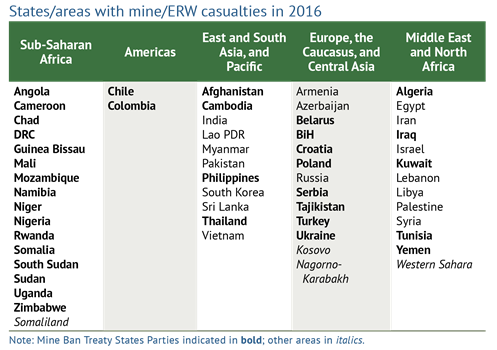

[1] Casualties from unexploded cluster submunitions (unexploded submunitions), which are cluster munition remnants, are included in the Monitor global mine/explosive remnants of war (ERW) casualty data. Casualties occurring during a cluster munition attack are not included in this data; however, they are reported in the annual Cluster Munition Monitor report. For more information on casualties caused by unexploded submunitions and the annual increase in those casualties recorded for the year 2016, see ICBL-CMC, Cluster Munition Monitor 2017, www.the-monitor.org/en-gb/reports/2017/cluster-munition-monitor-2017/casualties.aspx.
[2] For more information on explosive items recorded in casualty Monitor data, see the table “Mine/ERW types causing casualties,” at the end of this casualties overview.
[3] Landmine Monitor 2016 cited a figure of 6,461 mine/ERW casualties for 2015, however the number of casualties for 2015 and past years has been adjusted with newly available data.
[4] Previous annual totals are adjusted based on newly available data.
[5] The category “military and security forces” includes police as well as members of non-state armed groups and militia.
[6] For 2016, the civilian status was not recorded in data for 3,576 of the reported casualties. For 2015, the Monitor recorded 3,412 civilian casualties of 4,340 with known civilian status.
[7] In 2016, casualties were recorded in Afghanistan, Algeria, Angola, Armenia, Azerbaijan, Belarus, Bosnia and Herzegovina (BiH), Cambodia, Cameroon, Chad, Chile, Colombia, Croatia, Democratic Republic of the Congo (DRC), Egypt, Guinea-Bissau, India, Iran, Iraq, Israel, Kuwait, Lao PDR, Lebanon, Libya, Mali, Mozambique, Myanmar, Namibia, Niger, Nigeria, Pakistan, Palestine, Philippines, Poland, Russia, Rwanda, Serbia, Somalia, South Korea, South Sudan, Sri Lanka, Sudan, Syria, Tajikistan, Thailand, Tunisia, Turkey, Uganda, Ukraine, Vietnam, Yemen, Zimbabwe, and four other areas Kosovo, Nagorno-Karabakh, Somaliland, and Western Sahara. See table at the end of this chapter.
[8] A total decrease of 1,078 from updated 2015 numbers: Albania, Algeria, Armenia, Azerbaijan, Burundi, Cambodia, Colombia, Cyprus, Ecuador, Georgia, Kenya, Lebanon, Mali, Morocco, Mozambique, Namibia, Palestine, Philippines, Poland, Russia, Senegal, Serbia, Somalia, South Sudan, Sudan, Syria, Tajikistan, Zimbabwe, and other areas Abkhazia, Nagorno-Karabakh, and Western Sahara.
[9] With a total of 23 casualties in 2016: Israel, Sri Lanka, and other areas Kosovo and Somaliland.
[10] A total increase of 2,716 from updated 2015 numbers: Afghanistan, Angola, Belarus, BiH, Cameroon, Chad, Chile, Croatia, DRC, Egypt, Guinea-Bissau, India, Iran, Iraq, Kuwait, Lao PDR, Libya, Myanmar, Niger, Nigeria, Pakistan, Rwanda, South Korea, Thailand, Tunisia, Turkey, Uganda, Ukraine, Vietnam, and Yemen.
[11] These countries made up an increase of 2,316 casualties among the 2,716 total for all countries recording more casualties in 2016 than 2015.
[12] From 1999 through 2016, 112,646 mine/ERW casualties were recorded, including 28,597 people killed, 80,025 injured, and 4,024 for whom the survival or the fatal outcome of the explosive incident was not known.
[13] A survivor is a person who was injured by mines/ERW and lived.
[14] Casualties were identified in the following States Parties in 2016: Afghanistan, Algeria, Angola, Belarus, BiH, Cambodia, Cameroon, Chad, Chile, Colombia, Croatia, DRC, Guinea-Bissau, Iraq, Kuwait, Mali, Mozambique, Namibia, Niger, Nigeria, Philippines, Poland, Rwanda, Serbia, Somalia, South Sudan, Sudan, Tajikistan, Thailand, Tunisia, Turkey, Uganda, Ukraine, Yemen, and Zimbabwe.
[15] The casualty total for 2016 included the following types of sources, with there often being more than one source for some casualties in a given country: international organizations (3,505); UN and national mine action centers, including reporting from humanitarian mine action operators (2,475); humanitarian mine action operators (826); Monitor media scanning including media scanning by ICBL campaign members and Monitor researchers (362); other NGOs (1,323); and other UN agencies (114). For the year 2016, the Monitor collected casualty data from 22 different national or UN mine action centers in 21 states and other areas.
[16] See, Landmine Monitor 2016 for details on the lack of reporting on improvised mine casualties in Iraq, www.the-monitor.org/LM16.
[17] Data on injured persons was collected by HI and partners through interviews with displaced people and refugees in Syria, Jordan, and Lebanon between June 2013 and December 2015. Casualty data from Regional Emergency Response Office on the Syrian Crisis – HI, 27 May 2016. The reporting is based on interviews with 68,049 people assessed by HI teams, of which 25,097 were injured: 14,471 in Syria, 7,823 in Jordan, and 2,803 in Lebanon. See, HI factsheet, “Syria: A mutilated future,” Brussels, May 2016, pp. 1–2, bit.ly/HISyriaMay2016; and HI, “New Report: Syrians Maimed and Traumatized by Explosive Weapons,” 20 June 2016, bit.ly/HISyriaJune2016.
[18] ICRC, “Annual Report 2016,” Geneva, May 2017, p. 504, bit.ly/ICRC2016annual.
[19] ICRC, “Annual Report 2015,” Geneva, 2016, p. 526; and email from Rima Kamal, ICRC Yemen, 7 June 2016.
[20] ICRC, “Annual Report 2015,” Geneva, 2016, p. 526; and email from Rima Kamal, ICRC Yemen, 7 June 2016.
[21] Interview with Mohamed Al Osta, YEMAC Sanaa, April 2017.
[22] Information provided by UNDP Aden officer, in email from Aisha Saeed, Cluster Munition Monitor, 12 April 2017. Some slightly differing casualty figures were reported for the period, accordingly: by February 2017, 566 people injured by ERW in Aden, Abyan, and Lahj governorates and by March 2017, 632 people were injured by ERW since March 2015 in Aden, Abyan, Lahj, Al-Dhale, and Taizz. At least 17 wounded by landmines, including nine by antipersonnel mines. Email from Iskander Yousef, Danish Demining Group (DDG), 12 April 2017.
[23] The ICRC supported four hospitals in Benghazi, Misrata, Sabha, and Tripoli.
[24] ICRC, “Annual Report 2016,” Geneva, May 2017, pp. 154 and 156, bit.ly/ICRC2016annual.
[25] LibMAC data for 2015 listed an additional 340 IED casualties that were not included in Monitor records, including 66 emplaced IED casualties that did not indicate if the devices were command-detonated or victim activated.
[26] Monitor analysis of casualty data provided by Abdullatif H.M. Abujarida, IMSMA Manager, LibMAC, 23 May 2016; and Monitor media scanning for 1 January 2015 to 31 December 2015.
[27] Those hospitals lacked reliable and updated databases, therefore casualty numbers were likely underreported. Hospitals made the identification of the cause of injury. Some casualties recorded as due to ERW may have been casualties of IEDs. Email from Anne Barthes, HI, 26 May 2016.
[28] “ISIS Fighters Are Still Lurking in Surt, Libyan Officials Warn,” New York Times, 11 August 2016, www.nytimes.com/2016/08/12/world/middleeast/isis-fighters-are-still-lurking-in-surt-libyan-officials-warn.html.
[29] UN Security Council/Ban Ki-moon, “Report of the Secretary-General on the United Nations Support Mission in Libya,” S/2016/1011, 1 December 2016, para. 83.
[30] UN Security Council/António Guterres, “Report of the Secretary-General on the United Nations Support Mission in Libya,” S/2017/283, 4 April 2017, para. 95.
[31] The Monitor tracks the age, sex, civilian status, and deminer status of mine/ERW casualties to the extent that data is available and disaggregated.
[32] Child casualties are defined as all casualties where the victim is less than 18 years of age at the time of the incident.
[33] In 2016, child casualties were recorded in Afghanistan, Angola, Armenia, Belarus, Cambodia, Colombia, DRC, Egypt, Guinea-Bissau, India, Iran, Iraq, Lao PDR, Lebanon, Libya, Mali, Myanmar, Namibia, Pakistan, Palestine, Poland, Rwanda, Somalia, South Sudan, Sudan, Syria, Tajikistan, Thailand, Turkey, Uganda, Ukraine, Vietnam, Yemen, Zimbabwe, and two other areas Somaliland and Western Sahara.
[34] There were 1,055 boys and 242 girls recorded as casualties in 2016; the sex of 247 child casualties was not recorded.
[35] In 2016, casualties among deminers occurred in Afghanistan, Angola, BiH, Cambodia, Croatia, Iran, Iraq, Lebanon, Russia, Serbia, South Sudan, Thailand, Ukraine, Vietnam, Yemen, Zimbabwe and other area Nagorno-Karabakh.
[36] There were 1,783 casualties among deminers from 1999 through 2016. Since 1999, the annual number of demining casualties identified has fluctuated greatly, making it difficult to discern trends. Most major fluctuations have been related to the exceptional availability or unavailability of deminer casualty data from a particular country in any given year, and therefore cannot be correlated to substantive changes in operating procedures, international demining standards, or demining equipment.
[37] This includes only the casualties for which the civilian/military status was known; for 3,576 casualties the civilian status was not recorded.
[38] Afghanistan, Algeria, Colombia, DRC, Egypt, India, Iraq, Libya, Mali, Niger, Nigeria, Pakistan, Philippines, Syria, Thailand, Ukraine, and Yemen.
[39] Data on improvised mine (victim-activated IED casualties) included data from among the 445 casualties of explosive incidents categorized as “victim-activated” in the Action on Armed Violence (AOAV) explosive violence data set for 2016. AOAV casualty data for 2016 provided by email from Jennifer Dathan, Researcher, AOAV, 15 September 2017; and Monitor analysis of Armed Conflict Location and Event Data project (ACLED), “ACLED Version 7 All Africa 1997–2016,” and “ACLED Asia Running File 2016,” data for calendar year 2016. Approved citation: Raleigh, Clionadh, Andrew Linke, Håvard Hegre and Joakim Karlsen. 2010. Introducing ACLED-Armed Conflict Location and Event Data. Journal of Peace Research 47(5) 651-660.
[40] In 2016, antipersonnel mine casualties were recorded in: Afghanistan, Angola, BiH, Cambodia, Chile, Croatia, India, Iran, Iraq, Lebanon, Libya, Myanmar, Pakistan, South Korea, South Sudan, Sri Lanka, Sudan, Thailand, Ukraine, Western Sahara, Yemen, Zimbabwe, and other area Somaliland.
[41] In 2016, casualties from antivehicle mines were identified in the following states: Afghanistan, Angola, Cambodia, Egypt, Iran, Israel, Libya, Mali, Myanmar, Pakistan, South Korea, South Sudan, Sri Lanka, Sudan, Syria, Ukraine, Yemen, and other areas Nagorno-Karabakh and Western Sahara.
[42] The Monitor shares, cross-references, and compares data with the Geneva International Centre for Humanitarian Demining (GICHD) and the Stockholm International Peace Research Institute (SIPRI) Anti-vehicle mines (AVM) project. That project recorded 423 casualties from both confirmed and suspected antivehicle mines in 22 countries in 2016. GICHD-SIPRI casualty data provided by email from Ursign Hofmann, Policy Advisor, GICHD, 24 August 2017. See also, GICHD-SIPRI, “Anti-Vehicle Mines,” undated, www.gichd.org/mine-action-topics/human-security/anti-vehicle-mines-avm - .WfYW3Ygo9PY. Monitor and GICHD-SIPRI methodologies used to enter data differ, resulting in the differences in annual casualties reported. For example, Monitor data does not include casualties that occur to persons engaged in laying or emplacing mines. Monitor reporting does include politically disputed geographic “other areas” in reporting, and tends to use the definitions employed in original whole data sets when possible. In some cases, when an incident was attributed to both antivehicle mines and improvised mines in different sources, the Monitor included those as improvised mine casualties.
[43] In 2016, unspecified mine casualties were recorded in Cameroon, Chad, Egypt, Iran, Iraq, Kuwait, Libya, Mali, Niger, Rwanda, Somalia, Syria, Thailand, Tunisia, Turkey, Ukraine, Yemen, and other area Western Sahara.
[44] In 2016, Afghanistan, Angola, Armenia, Belarus, BiH, Cambodia, Chad, Colombia, DRC, Egypt, Guinea-Bissau, India, Iran, Iraq, Lao PDR, Lebanon, Libya, Mali, Mozambique, Myanmar, Namibia, Pakistan, Palestine, Philippines, Poland, Russia, Rwanda, Somalia, South Sudan, Sri Lanka, Sudan, Syria, Thailand, Turkey, Uganda, Ukraine, and other areas Kosovo, Somaliland, and Western Sahara. In addition to other types of ERW in 2016, 114 casualties of unexploded submunitions were identified in BiH, Iraq, Lao PDR, Lebanon, Libya, Serbia, South Sudan, Syria, Vietnam, and Yemen. For more information on casualties caused by unexploded submunitions and the annual increase in those casualties recorded for the year 2016, see ICBL-CMC, Cluster Munition Monitor 2017, www.the-monitor.org/en-gb/reports/2017/cluster-munition-monitor-2017/casualties.aspx.
[45] Of the total ERW casualties in 2016, 350 were civilian adults.
[46] They made up the vast majority of the casualties recorded for Yemen and Libya in 2016. In addition, 189 casualties of unknown mine/ERW items were killed, and for six the survival outcome was not known.
[47] Casualties from unknown mine/ERW items were recorded in 17 countries: Angola, Azerbaijan, Chad, Iran, Lebanon, Libya, Mali, Myanmar, Russia, Somalia, South Sudan, Sudan, Syria, Tajikistan, Ukraine, Yemen, and Zimbabwe.


